
Cauterizing Tools Page Menu: 1 2 3 4 5 6 Next>>
Cauterizing Tools of the Golden Age of Piracy, Page 2
Potential Cauteries
"Potential Cautery - an agent (as a caustic or escharotic) used to destroy tissue by chemical action."1

A Potential Cautery at Work, From Lorenz Heister's
A General System of Surgery, Plate 12 (1743)
Potential cauteries were placed on the skin at the point where it was required to be burned. They generally worked slower than actual cauteries and were a bit harder to control, so the surgeon had to take these factors into account when choosing them over the actual cauteries.
There were a variety of potential cauteries, some of which acted chemically and others which were simply heated to the point where they would burn the skin. Jacques Guillemeau noted that "we may make as manye sortes of cauteryes, as there are substances, which may be incended [heated to the point where they would burn]."2 Let's look at some of the particular potential cautery that were discussed by by period surgical authors
1 Potential Cauteries, Miriam Webster Dictionary Online, gathered 8/11/13; 2 Jacques Guillemeau, The French Chirurgerie, p. 23; 3
Potential Cauteries: Ægyptiacum
Ægyptiacum is a compound medicine, the primary cauterizing ingredient of which appears to be sulfuric acid. Herbalist James Rennie gives the recipe: "Take {17 ounce} of verdigrise (Subacetate of copper), {6 ounces} of alum [aluminum sulphate mixed with either potassium sodium or ammonium sulfate] in powder, {12 ounces} of vinegar, {10 ounces} of treacle. Boil gently together, and add {2.5 ounces} of sulphuric acid."1
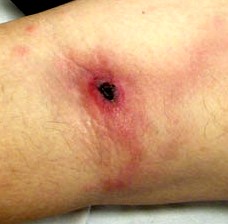
Photo: CDC - An Eschar
Sea surgeon John Woodall is the only proponent of the use of this caustic, although he gives it quite a write up in his treatment of gun shot wounds. Woodall advises the use of "Ægyptiacum mixed with Wine or Aquavitæ [brandy], or alone; being also very hot injected into the wound, or applied on linte. And if you feare it will require yet more exsiccation [drying - of humors in the wound], or cauterization, adde some burnt Vitriole"2.
If that failed to work, Woodall suggested scarification (creation of multiple incisions in the skin to allow the bad humors thought to be in the blood to escape) followed by treatment with hot lye and/or "Ægyptiacum with a hot stupe, and remove that dressing ...in lesse then 48 houres... if you have caused a good Esker [eschar - area of burned, dead skin]."3 He goes on to explain that while an eschar is produced as desired, "it is likely you shall finde digestion [the growth of new, healthy flesh] though unperfect, namely durty and fowle, and the wound will be very tender and sensible, and subject to alteration by the ayre, if care be not had."4 This may have been why he was the only one to advise the use of Ægyptiacum.
1 James Rennie, A New Supplement to the Pharmacopœpias of London, Edinburgh, Dublin and Paris, Baldwin and Cradock, p. 13; 2 John Woodall, the surgions mate, p. 143; 3 Woodall, ibid., 4 Woodall, p. 144
Potential Cauteries: Aqua Fortis [Nitric Acid]
Aqua fortis was also prepared from several elements. Apothecary James Rennie explained the process,
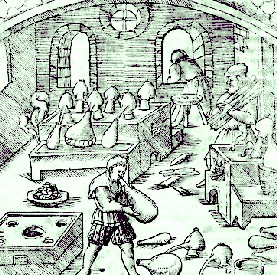
Making Ntric Acid, From De Re Metallica libri XII
, by Georg Bauer, p. 357 (1556)
beginning by taking "Nitre [potassium nitrate], green Vitriol not calcined [iron sulfate not preheated], of each three Pounds; of the same Vitriol calcined [the collected results of iron sulfate heated to a gaseous state], one Pound and half; mix all together and distil with a very strong Fire as long as red Fumes arise."1
While explaining how acids will not dissolve all soft substances, fellow herbalist and physician Robert James notes that the surgeon can see "the corrosive Virtue of Aqua Fortis in a thousand instances".2
Several period surgical authors include lists of potential cauteries in their books; aqua fortis is frequently found in such lists. Among those noting its usefulness as a cautery are Jaques Guillemeau3, Ambroise Paré4 and sea surgeons John Atkins5 and James Yonge6.
Sea surgeon John Woodall once again gives us a little more insight into this acidic compound, referring to it as 'strong water.' "I have, to satisfie some Surgeons, put this water into their [medicine] chests, but for my selfe I see no reason for it, I know no Chirurgicall use it hath which is not far better performed by oyle of vitrioll, wherefore I referre you rather to oyle of vitrioll, for it is a farre sweeter and surer medicine, as at large shall be spoken of in its place."7 As it shall indeed.
1 James Rennie, A New Supplement to the Pharmacopœpias of London, Edinburgh, Dublin and Paris, Baldwin and Cradock, p. 802; 2 Robert James, Pharmacopœia universalis, p. 85; 3 Jacques Guillemeau, The French Chirurgerie, p. 41; 4 Ambroise Paré, The Workes of that Famous Chirurgion Ambrose Parey, p.485; 5 John Atkins, The Navy Surgeon, p. 121; 6 James Yonge, Currus Triumpalis, é Terebinthô., p. 10; 7 John Woodall, the surgions mate, p. 61
Potential Cauteries: Arsenic
Apothecary

Photo: Aram Dulyan
Naturally Occuring Arsenic from Ste. Marie-aux-mines
Robert James explained that arsenic "properly so called, is a substance extracted from an Ore found in Saxony and Bohemia, named Cobalt."1 Physician James Rennie gives a different explanation, noting that while arsenic is sometimes found in it's natural state, it is "often combined with iron and cobalt. By roasting of the ores of these, the arsenic is sublimed, and combines with oxygen as it volatizes."2 James notes that it "has so strong a corrosive Quality, as sometimes to turn and ulcerate the Hands and Feet of the Miners, and is a deadly Poison for all known Animals."3
Several period surgeons include arsenic in their lists of potential cauteries, including military surgeon Richard Wiseman4 and sea surgeons John Atkins5 and James Yonge6. Of arsenics, sea surgeon John Woodall says they "are enemies to the life of man or beast taken into the body, this minerall killeth any living creature, and is of corroding quality, outwardly applied, it causeth a hard crusted scab with vehement burning, eateth away superfluous flesh, & taketh away haires."7 Although he clearly recognizes its causticity, Woodall does not recognize it in print as being a useful potential cautery.
1 Robert James, Pharmacopœia universalis, p. 542; 2 James Rennie, A New Supplement to the Pharmacopœpias of London, Edinburgh, Dublin and Paris, Baldwin and Cradock, p. 37; 3 James, p. 543; 5 John Atkins, The Navy Surgeon, p. 121; 6 James Yonge, Currus Triumpalis, é Terebinthô., p. 10; ,7 John Woodall, the surgions mate, p. 114
Potential Cauteries: Caustic Stones
Caustic
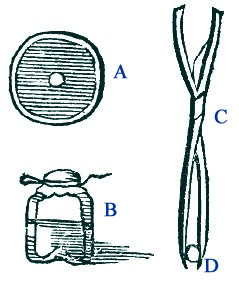
Potential Cautery and Tools: A - "litttle round
Plaister...with a hole in the middle', B -
' Bottle
of Caustics' C - Pincers for handling
stone
and D - The Cautery Stone,
Taken From
Cours d'Operation by Pierre
Dionis, Table
LVI, page
835 (1740)
stones were made specifically to be used as potential cauteries, to destroy damaged and 'proud' flesh. (Proud flesh being skin that had grown where it was not wanted.) When purchasing caustic stones, French surgical instructor Pierre Dionis advised his students to select only stones "of whose virtue and efficacy we are assured, for when we buy them from a third and fourth Hand, and sometimes of one, and others of another; we cannot answer for their Efficacy and Success, they may eat too deep, or too shallow, which may oblige us to lay on others."1
Dionis also recommended "that [so] the Chirurgeon may not be deceiv'd, he ought to make them himself, and keep them against an occasion, their Composition ...being very easy."2 His recipe for a caustic stone is as follows:
Into a Pail of Water we are to throw a Peck of Oak-Ashes, two Pound of Pot-Ashes, one Pound of Quick-lime [calcium oxide], and half a Pound of Salt; leave them to steep three or four Days, stirring them daily with a Stick. All the Ingredients being well settled, we are to strain them so well that nothing may pass but very clear Water, which we pour into a Kettle over the Fire, making it boil till the Water turns to a black Stone3
Of course, this is just one method; like other potential caustics, there were a wide variety of ways to create a caustic stone. French surgeon Jacques Guillemeau provides his readers with seven different recipes for them, most of which are culled from the writings of other authors. We will look at one of them, which he calls the cautery of velvet.
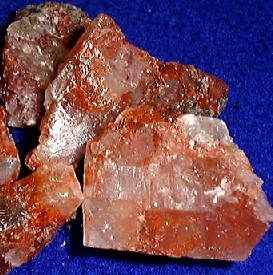
Photo: US Government - Potash
Guillemeau proclaims it to be 'one of the best'.
Take sault of glasse [A mixture of the salts found in raw materials used to make glass, including potassium carbonate, sodium chloride, sodium sulfate and potassium sulfate.], Potashes, unslist [unslaked] lime [calcium oxide], of each a pownde, ashes which are burned on the inveterate sydes of a wynepipe [wine pipes are not actually pipes, but barrels], two pownde. Put all these together in a great earthen pott, & infuse theron 18, or 20, pownd of cleere water, and let it so stande soackinge 8. or 10 dayes... with a sticke daylye stirringe of the same, and then we must lett it to clarifye, and sincke, wherof you must defuse the uppermost therof, and ether straygne it throughe a thicke close cloute [cloth], or els throughe a Pelt, without stirringe [up] of the bottom or fœces [solid particles that have settled to the bottom] therof, of which æqual parte, you must make Trociskes [a small, pill-sized stone]4
The other stones Guillemeau describes include several similar ingredients.
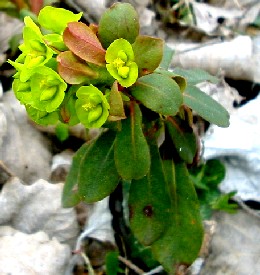
Euphorbia - Wood Spurge
These include potash, wood ashes, lime, salts of glass, pulverised sal alcali (potassium sulfate) and lye. For the wood ashes, Guillemeau suggests they be "made of Oacke[n] wood,
of Giggetreewoode, of VineBranches, of Beanestrawe, of Cabbage stalkes, and of Titimallo [euphorbia plants]."5 Like the process for making the cautery of velvet, these ingredients were typically added to water and left standing for a week or two, after which the upper, clearer liquid is strained and used to make the stones.
When explaining how to go about treating a hernia, Military surgeon Richard Wiseman describes another type of caustic stone, which he believes is "more easie [on the patient]. The mildest of them is Soap-lees boiled to a stone, with the addition of sevum vitulin [veal tallow]. And a fourth part of opium added to it at the last."6 Lees used in making soap are the dregs drawn from potash and lime.7 The opium is added to reduce the amount of pain the caustic stone caused as it burned.
Once made, such caustic stones had to be cared for properly or surgeons felt they would lose their potency. Pierre Dionis advises that the finished stone be broken "into small Stones which we put into Glass Vials , and stopping them very well [see the image at the beginning of this section], keep them in a warm and dry place."8 He further warns that caustic stones that "are too moist, and have not been kept in a dry place... never perform’d so well [as those that were stored properly]."9
1, 2, 3 Pierre Dionis, A course of chirurgical operations: demonstrated in the royal garden at Paris. 2nd ed., p. 468; 4 Jacques Guillemeau, The French Chirurgerie, p. 42; 5 Guillemeau, [p. 41-2; 6 Richard Wiseman, Eight Chirurgicall Treatises, 3rd Edition, p. 153; 7 Soap, Encyclopedia Britannica, Fourth Edition, Vol XIX, p. 433; 8 Dionis, p. 468; 9 Dionis, ibid.
Potential Cauteries: Heated Substances
As
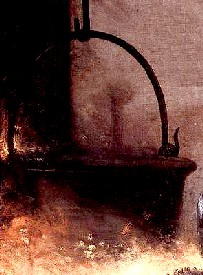
Artist: Bernardo Strozzi
Heating Over the Fire, Taken from
The Cook (1625)
Jacques Guillemeau noted in the quote at the beginning of this page, nearly anything could be heated to the point where it would serve as a cauterizing agent. (This is how actual cauteries or cauterizing irons work, after all.) It could be argued that heating substances to the point where they will burn skin makes them actual cauteries, but since noted French surgeon Ambroise Paré included "scalding oil, melted sulphur, and boiling, and the like" in his list of potential cauteries1, we will do likewise. (Curiously, a book claiming to be "gathered out of Ambroisius Pareus, and done unto English" by Helkiah Crooke suggests that "melted Lead, scalding water, roots of Gentian and the like burnt red hot" are actual cauteries.2)
Guillemeau provides a list of some items that serve as cauteries when heated 
Surgical Author Ambroise Paré
including "seethi[n]ge oyle, or with drye incended puffes as we call them or with the root Aristolociæ [Aristolochia], being madefyed [moistened] in seething oyle, or with the rootes of strutium [possibly saponaria]"3.
Guillemeau goes on to list a variety of surgeons throughout history who used such cauteries, "as Cælius Aurelianus [5th century Roman physician], Dioscorides [Pedanius Dioscorides - 1st century Greek physician], and Attilus [probably Athenaeus of Attalia, 1st century Roman physician], which have cauterized with incended Goates dung. Ætius [Aëtius of Amida, 5th/6th century Byzantine phyisician] hath cauterised the corrupted gummes, with ebullient [boiling] oyle, which he applyed theron with wolle [wool] beinge therin madyfied [moistened]. Albucasis [10th century Arabic physician] in like sorte, hath cauterized the hollowe, and concavouse teeth with seethinge [boiling] butter. Guido [probably Guido da Vigevan, 11th/12th century Italian phyisican] hath cauterised the bones, with liquefacted Brimstone, to witt of the Caries [bone decay]."4
However, it should be noted that boiling oil as a cautery had widely fallen out of favor as a cautery after the 16th century when Ambroise Paré discovered through experimentation that it did more harm than good.
1 Ambroise Paré, The Workes of that Famous Chirurgion Ambrose Parey, p.485; 2 Helkiah Crooke, An explanation of the fashion and use of three and fifty instruments of chirurgery, p. 7; 3 Jacques Guillemeau, The French Chirurgerie, p. 40; 4 Guillemeau, p. 40,

